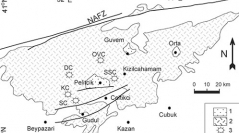

 Comptes Rendus Palevol
8 (5) - Pages 437-446
Comptes Rendus Palevol
8 (5) - Pages 437-446The palynological investigation of the early Middle Miocene fluviolacustrine sedimentary rocks interfingering with volcanics of the Galatean Volcanic Province at Pelitçik Basin (Central Turkey) have yielded palynomorphs belonging to 51 spore and pollen taxa. The pollen record is dominated by Ulmus, Pinaceae, Quercus, Carpinus and Carya, and appears to reflect climatic conditions. Two pollen zones were established based on changing abundances of plant taxa. Zone 1 is characterized by dominance of Ulmus and Pinaceae. Zone 2 is differentiated and characterized by a dramatic increase in, and predominance of, Ulmus, Carya , deciduous Quercus, Carpinus, Salix and Pinaceae. Mixed mesophytic forests were widespread in the basin suggesting warm and temperate climate. The decreasing relative percentage of thermophilous taxa, with Engelhardia as the main component, and warm temperate taxa, such as Carya, at the upper part of Zone 2 generally indicates a climatic deterioration, probably related to the Middle Miocene cooling.
Palynology, Palaeovegetation, Early Middle Miocene, Pelitçik Basin, Turkey